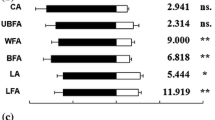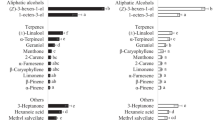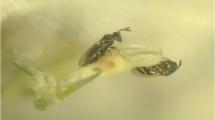Abstract
Olfactory attraction of female diamondback moths (Plutella xylostella) to odors of intact and homogenized host plants, as well as individual compounds characteristic of host plants, were investigated by behavioral and electrophysiological methods. Moths were attracted to odors ofBrassica juncea andB. napus seedlings in a Y-tube bioassay. Solvent fractions of homogenizedB. juncea leaves were attractive to moths whether or not isothiocyanates (IC) were present. Moths were attracted in Y-tube bioassays and to field traps baited with individual ICs. Volatiles fromB. juncea andB. napus elicited an electroantennogram (EAG) response and were attractive in the Y-tube bioassay. Allyl IC was shown to be the attractive component in homogenized plant volatiles but was found to be virtually absent from intact plant volatiles. Gas chromatographic fractionation of intact plant volatiles revealed a terpene-containing fraction to be most attractive to the moths. We were unable to isolate individual attractive compounds from this fraction. Our results suggest that certain elements of this fraction, possibly in combination, are important olfactory cues for host-plant finding by the diamondback moth with mustard oils playing an important and possibly synergistic role, particularly when plants are damaged.
Similar content being viewed by others
References
Averill, A.L., Reissig, W.H., andRoelofs, W.L. 1988. Specificity of olfactory responses in the tephritid fruit fly,Rhagoletis pomonella Entomol. Exp. Appl. 47:211–222.
Chisholm, M.D., andWetter, L.R. 1967. The biosynthesis of some isothiocyanates and oxazolidinethiones in rape (Brassica campestris L.).Plant Physiol. 42:1726–1730.
Chisholm, M.D., Steck, W.F., Arthur, A.P., andUnderhill, E.W. 1975. Evidence forcis-11-hexadecen-1-ol acetate as a major component of the sex pheromone of the bertha armyworm.Can. Entomol. 107:361–366.
Feeny, P., Paauwe, K.L., andDemong, N.J. 1970. Flea beetles and mustard oils: Host-plant specificity ofPhyllotreta cruciferae andP. striolata adults (Coleoptera: Chrysomelidae).Ann. Entomol. Soc. Am. 63:832–841.
Finch, S., andSkinner, G. 1982. Trapping cabbage root flies in traps baited with plant extracts and with natural and synthetic isothiocyanates.Entomol. Exp. Appl. 31:133–139.
Free, J.B., andWilliams, I.H. 1978. The responses of the pollen beetleMeligethes aeneus, and the seed weevil,Ceutorhynchus assimilis, to oil-seed rape,Brassica napus, and other plants.J. Appl. Ecol. 15:761–774.
Grob, K., andGrob, G. 1974. Organic substances in potable water and in its precursor. Part II. Applications in the area of Zurich.J. Chromatogr. 90:303–313.
Harris, L.E. 1970. Nutrition Research Techniques for Domestic and Wild Animals, Vol. I. Utah State University, Logan, Utah, 65 pp.
Kennedy, J.S. 1977. Olfactory responses to distant plants and other odour sources. Chapter 5,in H.H. Shorey andJ.J. McKelvey, Jr. (eds.). Chemical Control of Insect Behavior. Theory and Application. John Wiley & Sons, New York.
Kjaer, A. 1960. Naturally derived isothiocyanates (mustard oil) and their parent glucosides.Fortschr. Chem. Org. Naturst. 18:122–176.
Kjaer, A., Gmelin, R., andLarsen, I. 1955. Isothiocyanates. II. 3-Methylthiopropyl isothiocyanate (ibervin), a new naturally occurring mustard oil.Acta Chem. Scand. 9:1143–1147.
Lampman, R.L., Metcalf, R.L., andAndersen, J.F. 1987. Semiochemical attractants ofDiabrotica undecimpunctata howardi Barber, the southern corn rootworm, andDiabrotica virgifera virgifera LeConte, the western corn rootworm (Coleoptera: Chrysomelidae).J. Chem. Ecol. 13:959–975.
Light, D.M., Jang, E.B., andDickens, J.C. 1988. Electroantennogram responses of the Mediterranean fruit fly,Ceratitis capitata, to a spectrum of plant volatiles.J. Chem. Ecol. 14:159–180.
Ma, W.-C., andVisser, J.H. 1978. Single unit analysis of odour quality coding by the olfactory antennal receptor system of the Colorado beetle.Entomol. Exp. Appl. 24:320–333.
Matsumoto, Y. 1970. Volatile organic sulfur compounds as insect attractants with special reference to host selection, pp. 133–160,in D.L. Wood, R.M. Silverstein, and M. Nakajima (eds.). Control of Insect Behavior by Natural Products. Academic Press, New York.
Metcalf, R.L. 1987. Plant volatiles as insect attractants.CRC Crit. Rev. Plant Sci. 5:251–301.
Palaniswamy, P., Gillott, C., andSlater, G.P. 1986. Attraction of diamondback moths,Plutella xylostella (L.) (Lepidoptera: Plutellidae) by volatile compounds of canola, white mustard, and faba bean.Can. Entomol. 118:1279–1285.
Pivnick, K.A., andJarvis, B.J. 1991. Rate of release of allyl isothiocyanate by intact and damaged Oriental mustard plants and implications for host plant location by insects.Proc. GCIRC VIII Int. Cong. 512–517.
Pivnick, K.A., Jarvis, B.J., Slater, G.P., Gillott, C., andUnderhill, E.W. 1990. Attraction of the diamondback moth (Lepidoptera: Plutellidae) to volatiles of Oriental mustard: The influence of age, sex, and prior exposure to mates and host plants.Environ. Entomol. 19:704–709.
Pivnick, K.A., Reed, D.W., Millar, J.G., andUnderhill, E.W. 1991. Attraction of northern false chinch bug,Nysius niger (Heteroptera: Lygaeidae), to mustard oils.J. Chem. Ecol. 17:931–941.
Pivnick, K.A., Lamb, R.J., andReed, D. 1992. Response of flea beetles,Phyllotreta spp., to mustard oils and nitriles in field trapping experiments.J. Chem. Ecol. 18:863–873.
Read, D.P., Feeny, P.P., andRoot, R.B. 1970. Habitat selection by the aphid parasite,Diaeretiella rapae, (Hymenoptera: Braconidae) and hyperparasiteCharips brassicae (Hymenoptera: Cynipidae).Can. Entomol. 102:1567–1578.
Reed, D., Pivnick, K.A, andUnderhill, E.W. 1989. Identification of chemical oviposition stimulants for the diamondback moth,Plutella xylostella, present in three species of Brassicaeceae.Entomol. Exp. Appl. 53:277–286.
Shimizu, T., andUsui, K. 1986. Electrophysiological investigations on the response to cabbage odour by the cabbage armyworm mothMamestra brassicae (Lepidoptera: Noctuidae).Zool. Sci. 3:867–871.
Slater, G.P. 1992. Allyl thiocyanate—natural product or artifact in crucifer extracts?Chromatographia 34:461–467.
Smith, D.B., andSears, M.K. 1982. Evidence for dispersal of diamondback moth,Plutella xylostella (Lepidoptera: Plutellidae) into southern Ontario.Proc. Entomol. Soc. Ont. 113:21–27.
Tollsten, L., andBergstrom, G. 1988. Headspace volatiles of whole plants and macerated plant parts ofBrassica andSinapis.Phytochemistry 27:2073–2077.
Visser, J.H. 1986. Host odour perception in phytophagous insects.Annu. Rev. Entomol. 31:121–144.
Visser, J.H. 1988. Host-plant finding by insects: Orientation, sensory input and search patterns.J. Insect Physiol. 34:259–268.
Visser, J.H., andAvé, D.A. 1978. General green leaf volatiles in the olfactory orientation of the Colorado potato beetleLeptinotarsa decemlineata.Entomol. Exp. Appl. 24:528–549.
Wallbank, B.E., andWheatley, G.A. 1979. Some responses of cabbage root fly (Delia brassicae) to allyl isothiocyanate and other volatile constituents of crucifers.Ann. Appl. Biol. 9:1–12.
Author information
Authors and Affiliations
Rights and permissions
About this article
Cite this article
Pivnick, K.A., Jarvis, B.J. & Slater, G.P. Identification of olfactory cues used in host-plant finding by diamondback moth,Plutella xylostella (Lepidoptera: Plutellidae). J Chem Ecol 20, 1407–1427 (1994). https://doi.org/10.1007/BF02059870
Received:
Accepted:
Issue Date:
DOI: https://doi.org/10.1007/BF02059870




